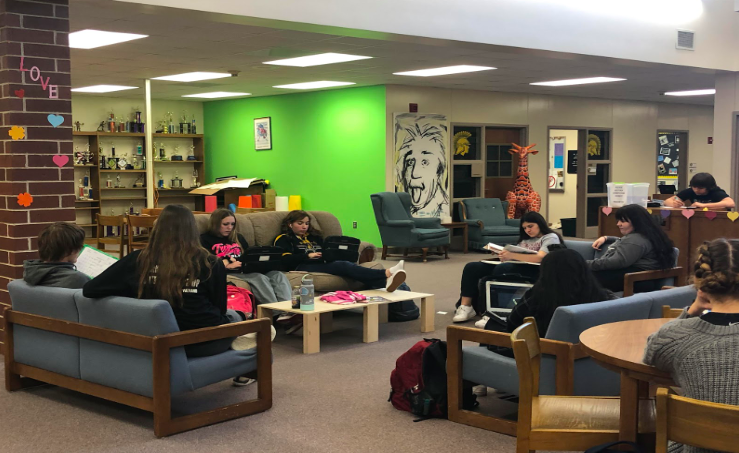Changing the Culture
It comes up at school board meetings, in class, and on the news.
Students in the library study during their free period. The couches are open to anybody during this time. They are used for comfort and socializing, the interactions helping improve the student culture.
February 12, 2020
School culture is a major part about attending high school. Friends, teachers, and acquaintances are all key points to a school’s culture. Relationships drive a school’s culture. “The school is about relationships,” Atlantic High School principal Heather McKay said. “People perform better, learn better, and grow better when they feel others are invested in them and cared for, and it goes both ways. You learn best and grow best when you feel connected.”
According to Malone University, “School culture is the beliefs, perceptions, attitudes, and written and unwritten rules that influence every aspect of a school.” From the moment a student walks in the door, the school’s culture between the students and staff members drive what that day is going to be like. “Culture drives everything, everything you allow to happen, or that you choose to do. That’s your culture and that establishes what the place is going to be like,” Dan Vargason, Head of the Climate and Culture Committee, said. “If you allow bad habits, or toxic attitudes, that’s what your program is going to be like. If you expect success and you expect positives, that’s what you are going to get,” he said.
“At the foundation of school culture lays the mission and vision for the school. Underlying the mission and vision statements are the values the school holds. The mission and vision mirror what the school wishes and hopes to eventually become and accomplish. These help individuals feel a sense of shared responsibility and passion, and allows for a deeper spiritual and emotional connection to a common purpose. Values are expressed as the way the school communicates what it represents and ushers decision-making and priorities,” Sara Confeld said in her research paper.
“I think we have an improving school culture. It’s not where I want it to be, but it’s not where it once was,” McKay said.
There have been many things the school has done to improve the culture. This year, the school created committees within the faculty. The teachers and administrators have been discussing where they would like students to be at graduation, and how to get students ready for life after high school. For several years, professional development has been about developing relationships, understanding relationships, and understanding other people in those relationships. “There are a lot of opportunities to get involved and interact with each other, so I think by having students involved, I think that’s a big positive,” Vargason said.
There have been several teachers who have been helpful in improving the school’s culture. “I’m going to use sporting events as an example, because I’m very old school,” McKay said. “I do not like ‘airball,’ I don’t like singling people out, and I almost started to be too strict, and it wasn’t fun for anybody. Then, Ms. Berryhill and Mr. Vargason came to me at one time and had different conversations. And so, I had some really good conversation about how they are trying to develop things.” McKay went on to say, “I want us to have fun at events, but I want it to be good fun.”
Not only has the culture been improving through activities, it’s also been improving through relationships. The relationship between students and teachers has improved. “I can’t speak for other teachers, but a lot of the teachers I do know have very positive relationships with their students, and care about the kids. Ultimately that’s our job, to teach you. But if we don’t care about you, we can’t really help you,” Vargason said. “Most of our teachers want to build relationships with students and create a positive environment.”
The culture between staff members has also improved. “I think our staff culture has improved a lot. When I first came here, we got along but didn’t interact. Now, I think it has changed,” Vargason said. “It’s a lot more about positive relationships between staff members. A lot of the staff has the kids in mind, and we are on the same page.”
Even though the school’s culture has improved a lot, there are still some areas that need improving. “A negative right now is people stepping out of their involvement,” Vargason said. “The more kids we get in activities–whether it be sports or fine arts–the more interactions we have, the better. I’ve seen a little bit of a decline in those.”
Another way students can lighten the mood in school is to go in with a good outlook on the day and their peers. McKay said, “Nonverbal communication is huge. A smile makes a huge difference. It’s so small, but it really does make a difference.” She also said, “If you start focusing on the positive, more positive things happen.”
Through involvement and caring relationships, the school’s culture has improved. With a positive attitude, an increase in involvement, and a smile, the culture of AHS can continue to get better with the help of students and staff.










